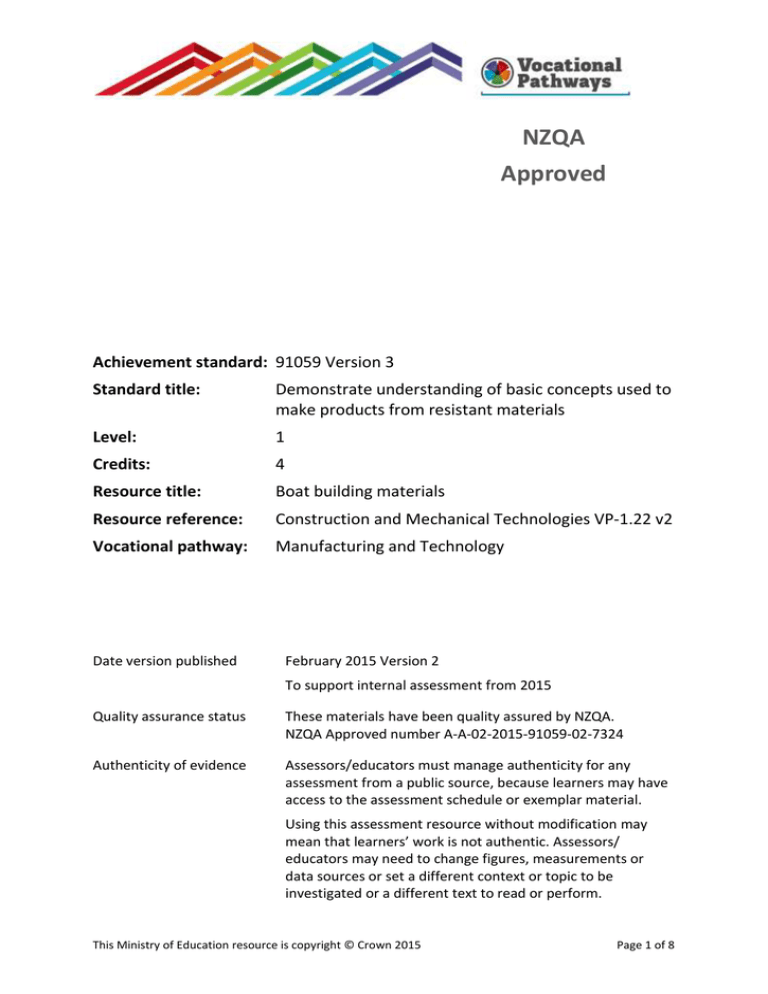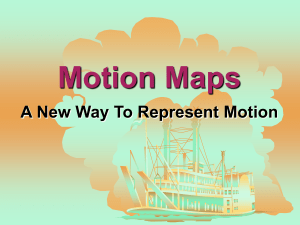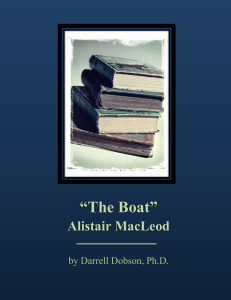Boat building materials v2 - MT (Word 2007, 502 KB)
advertisement

NZQA Approved Achievement standard: 91059 Version 3 Standard title: Demonstrate understanding of basic concepts used to make products from resistant materials Level: 1 Credits: 4 Resource title: Boat building materials Resource reference: Construction and Mechanical Technologies VP-1.22 v2 Vocational pathway: Manufacturing and Technology Date version published February 2015 Version 2 To support internal assessment from 2015 Quality assurance status These materials have been quality assured by NZQA. NZQA Approved number A-A-02-2015-91059-02-7324 Authenticity of evidence Assessors/educators must manage authenticity for any assessment from a public source, because learners may have access to the assessment schedule or exemplar material. Using this assessment resource without modification may mean that learners’ work is not authentic. Assessors/ educators may need to change figures, measurements or data sources or set a different context or topic to be investigated or a different text to read or perform. This Ministry of Education resource is copyright © Crown 2015 Page 1 of 8 Internal assessment resource: Construction and Mechanical Technologies VP-1.22 v2 – Vocational pathway: Manufacturing and Technology PAGE FOR LEARNER USE Vocational Pathway Assessment Resource Achievement standard: 91059 Standard title: Demonstrate understanding of basic concepts used to make products from resistant materials Level: 1 Credits: 4 Resource title: Boat building materials Resource reference: Construction and Mechanical Technologies VP-1.22 v2 Vocational pathway: Manufacturing and Technology Learner instructions Introduction This assessment activity requires you to create a report that demonstrates your understanding of basic concepts used to make products from resistant materials used in boat building. You are going to be assessed on how comprehensively you demonstrate your understanding of basic concepts used to make products from resistant materials used in boat building. The following instructions provide you with a way to structure your work so you can demonstrate what you have learnt and achieve success in this standard. Assessor/educator note: It is expected that the assessor/educator will read the learner instructions, and modify them if necessary to suit their learners. Task Produce a report that demonstrates your understanding of basic concepts used to make products from boat building materials, for example aluminium, fibreglass, wood, steel. Make sure you do the following: describe characteristics of boat building materials such as profile, hardness, malleability, strength and stiffness explain safe techniques to be used with boat building materials. The techniques must cover one or more from each of the following four categories: - measuring or marking out - sizing, shaping, or forming - joining or assembly - finishing, detailing or tuning This Ministry of Education resource is copyright © Crown 2015 Page 2 of 8 Internal assessment resource: Construction and Mechanical Technologies VP-1.22 v2 – Vocational pathway: Manufacturing and Technology PAGE FOR LEARNER USE explain how the characteristics of boat building materials influence safe technique selection: - for example how the characteristics of fibreglass influence the way it is shaped safely explain which combinations of techniques (shown above) and boat building materials would be suitable for use in a situation, for example: - explain how fibreglass sheeting for a kitchen area in a small boat could be measured out - explain the joining techniques that could be used for aluminium panels in a dingy discuss why boat building materials require particular techniques for their safe handling and use: - for example discuss the importance of protective safety glasses and safe practices when working with fibreglass, and/or why a protective tent may be required when spray painting, sanding and finishing a fibreglass hull discuss why techniques and boat building materials are combined in different ways across two or more situations: - for example discuss why different areas of the boat require different strengths or why in boats where weight is significant, different assembling techniques are required, such as with firbreglass. The situations you could consider that would impact on materials characteristics and their techniques could include: wet or dry area ease or optimisation of production one-off versus mass production budget constraints life expectancy maintenance plan target market, for example the age group of the end users, the quality expectation of the end users position of the material within the product. This Ministry of Education resource is copyright © Crown 2015 Page 3 of 8 Internal assessment resource: Construction and Mechanical Technologies VP-1.22 v2 – Vocational pathway: Manufacturing and Technology PAGE FOR ASSESSOR/EDUCATOR USE Vocational Pathway Assessment Resource Achievement standard: 91059 Standard title: Demonstrate understanding of basic concepts used to make products from resistant materials Level: 1 Credits: 4 Resource title: Boat building materials Resource reference: Construction and Mechanical Technologies VP-1.22 v2 Vocational pathway: Manufacturing and Technology Assessor/Educator guidelines Introduction The following guidelines are supplied to enable assessors/educators to carry out valid and consistent assessment using this internal assessment resource. As with all assessment resources, education providers will need to follow their own quality control processes. Assessors/educators must manage authenticity for any assessment from a public source, because learners may have access to the assessment schedule or exemplar material. Using this assessment resource without modification may mean that learners' work is not authentic. The assessor/educator may need to change figures, measurements or data sources or set a different context or topic. Assessors/educators need to consider the local context in which learning is taking place and its relevance for learners. Assessors/educators need to be very familiar with the outcome being assessed by the achievement standard. The achievement criteria and the explanatory notes contain information, definitions, and requirements that are crucial when interpreting the standard and assessing learners against it. Context/setting This activity requires learners to present evidence of their comprehensive understanding of basic concepts used to make products from boat building materials. Learners will need to show that they can process and interpret information, and prepare a report that discusses why resistant materials require particular techniques for their safe handling and use, and why techniques and resistant materials are combined in different ways across two or more situations. Conditions Learners could work independently or in groups to develop their understanding, but they need to create their report independently, and will be assessed individually. This Ministry of Education resource is copyright © Crown 2015 Page 4 of 8 Internal assessment resource: Construction and Mechanical Technologies VP-1.22 v2 – Vocational pathway: Manufacturing and Technology PAGE FOR ASSESSOR/EDUCATOR USE Resource requirements Assessors/educators will provide learners with the opportunities to explore a range of products made from boat building materials in order to discuss the materials used, their characteristics and the techniques that would be appropriate to work with them safely. Additional information None. This Ministry of Education resource is copyright © Crown 2015 Page 5 of 8 Internal assessment resource: Construction and Mechanical Technologies VP-1.22 v2 – Vocational pathway: Manufacturing and Technology PAGE FOR ASSESSOR/EDUCATOR USE Assessment schedule: Construction and Mechanical Technologies 91059 – Boat building materials Evidence/Judgements for Achievement Evidence/Judgements for Achievement with Merit Evidence/Judgements for Achievement with Excellence The learner demonstrates understanding of basic concepts used to make products from boat building materials by: describing characteristics of boat building materials For example: - the learner uses terms such as profile, hardness, malleability, strength, and stiffness to describe the characteristics of materials such as aluminium, fibreglass, steel and plywood. explaining safe techniques to be used with boat building materials For example, the learner explains safe techniques used with boat building materials for at least one of each of the following categories: - measuring/marking out, e.g. how to measure out the resin and hardener required for fibreglassing and considering such things as ventilation and the use of personal protective equipment - sizing/shaping/forming, e.g. how to cut fibreglass matting to size and form the fibreglass shape, how to cut metal, the personal protection equipment that should be used - joining/assembling, e.g. how to weld metal The learner demonstrates in-depth understanding of basic concepts used to make products from boat building materials by: explaining how the characteristics of boat building materials influence safe technique selection For example: - the learner uses terms such as profile, hardness, malleability, strength, and stiffness to explain the characteristics of aluminium, fibreglass, steel and plywood. explaining safe techniques to be used with boat building materials For example, the learner explains safe techniques used with boat building materials for at least one of each of the following categories: - measuring/marking out, e.g. how adding hardener to resin gives fibreglass its strength characteristics, why eyes must be protected, the working space must be well ventilated and the measuring done accurately - sizing/shaping forming, e.g. how matting that is woven with glass strands and catalysed resin is used in fibreglassing to achieve a material that is strong and light, how gloves must be used when trimming The learner demonstrates comprehensive understanding of basic concepts used to make products from boat building materials by: discussing why boat building materials require particular techniques for their safe handling and use For example: - the learner uses terms such as profile, hardness, malleability, strength, and stiffness when discussing the characteristics of materials such as aluminium, fibreglass, steel and plywood - the learner discusses the potential dangers of working with resin and how eyes must be protected and the working space must be well ventilated. explaining safe techniques to be used with boat building materials For example, the learner explains safe techniques used with boat building materials for at least one of each of the following categories: - measuring/marking out, e.g. why, when working with resin, measuring must be accurate; why adding the right ratio of hardener to resin must be used; how techniques are affected by temperature, humidity, the thickness of the application, This Ministry of Education resource is copyright © Crown 2015 Page 6 of 8 Internal assessment resource: Construction and Mechanical Technologies VP-1.22 v2 – Vocational pathway: Manufacturing and Technology PAGE FOR ASSESSOR/EDUCATOR USE sheets, the personal protection equipment the hardened matting as the edges will be that should be used very sharp - finishing/detailing/tuning, e.g. the safe - joining/assembling, e.g. how aluminium is a techniques for painting metal are good material to use in boat building considered, including ventilation and because of its strength, stiffness and flammability concerns, and the personal malleability, how sheets can be riveted or protection equipment that should be used. welded and these characteristics maintained. The safety techniques describing which combinations of techniques associated with welding are explained and boat building materials would be suitable - finishing/detailing/tuning, e.g. how steel is for use in a situation a good metal to use in boat building For example, the learner describes: because of its strength, how it can rust so - how teak (a softwood) could be used on the needs to be painted (sometimes with lead deck of a boat. The wood could be joined paint). The need for ventilation and with glue, screws, rivets and/or nails. The protective gear to be worn is explained. natural oil of teak must first be wiped off with a chemical cleaner to allow a join to be explaining which combinations of techniques and boat building materials would be suitable glued effectively for use in a situation - how harder woods would be needed for For example, the learner explains: the hull – planks could be fastened to a frame and keel. - how the high strength to weight ratio of aluminium makes it a suitable material The above expected learner responses are when speed is important indicative only and relate to just part of what is required. - how fibreglass is good for mass production as making the initial mould is time consuming but then time is reduced for subsequent work. How the use of the sandwich technique where core materials are used adds stiffness and rigidity. The special care needed when handling the chemicals used in the resin and the clean up - the use of steel to build coastal cruisers and how this makes them rugged and heavy and This Ministry of Education resource is copyright © Crown 2015 quantity of mix, type of resin, whether a colour agent is used - sizing/shaping/forming, e.g. why a gel coat of fibreglassing may have metal flakes or pigment added, depending on the desired finish; how the skin coat may have either chopped, roving or glass mat fibres added, and how the number of layers depends on the desired thickness; why it is necessary to wear gloves when trimming hardened fibreglass matting - joining/assembling, e.g. the strength, stiffness and malleability of aluminium and why this makes it a good material to use in boat building; the pros and cons of riveting and welding sheets in maintaining these characteristics; the different situations that would make riveting or welding the preferred joining technique; when the characteristics of the aluminium allow TIG (rather than MIG) welding to be used; the safety techniques associated with welding - finishing/detailing/tuning, e.g. why the strength of steel makes it a good material to use in particular boat building situations; how the painting preparation techniques will depend on whether the steel has a mill scale surface or is wheel abraded preprimed; the importance of preventing corrosion and how the preparation/priming/painting techniques will depend on whether it is on a surface above or below the water line, on a deck etc.; the dangers and safe techniques to be Page 7 of 8 Internal assessment resource: Construction and Mechanical Technologies VP-1.22 v2 – Vocational pathway: Manufacturing and Technology PAGE FOR ASSESSOR/EDUCATOR USE the benefits of this. How the steel can be used in large pieces and assembled quickly. How care must be taken when welding so as not to distort the plates. The above expected learner responses are indicative only and relate to just part of what is required. used with lead based paint. discussing why techniques and boat building materials are combined in different ways across two or more situations For example, the learner discusses: - why boats used in situations that require less weight (e.g. racing yachts, boats that carry cargo or lots of people) may be best to be made using the foam sandwich technique of fibreglassing, rather than the single sheet technique - situations where such factors as budget, ease of repair, the chance of impact, the possible need to add fittings at a later date, the skills of the boat builder and the size of the boat will have a bearing on whether single skin, foam core or plywood core techniques are used. The above expected learner responses are indicative only and relate to just part of what is required. Final grades will be decided using professional judgement based on an examination of the evidence provided against the criteria in the Achievement Standard. Judgements should be holistic, rather than based on a checklist approach. This Ministry of Education resource is copyright © Crown 2015 Page 8 of 8




